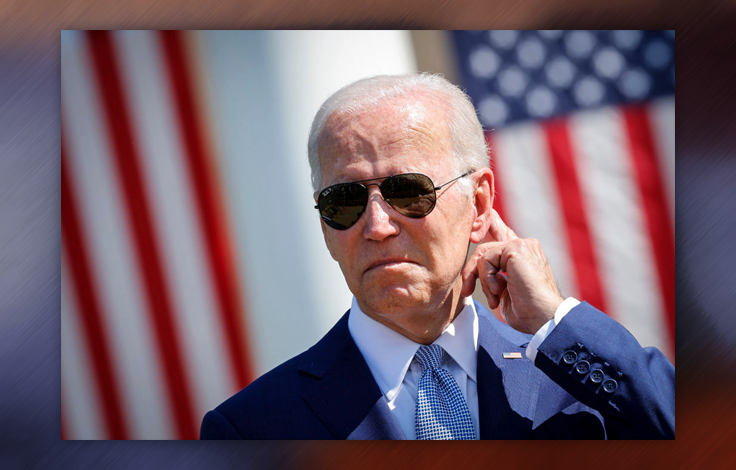Over the last four months, President Joe Biden has rolled out a series of immigration policies that could just as easily have emerged from former president Donald Trump's administration: a hard cap on the number of Latin Americans who can claim asylum in the United States, temporary deportation to Mexico for those asylum seekers, and a planned reimplementation of detaining migrant families behind bars.
Staring down an estimated 5.5 million southern border crossings since the president took office—the most in U.S. history—Democratic strategists say Biden's 180-degree pivot on immigration underscores his vulnerability on the issue as he prepares to run for a second term. Polling suggests the issue is a liability for the president: A March Associated Press poll found that just 39 percent of U.S. adults approve of his handling of immigration, while just 38 percent approve of his response to the border crisis.
"I think the electorate is much closer to the center on immigration than where the White House has been," said Democratic political consultant Mike Mikus, who has worked for the Democratic Congressional Campaign Committee and the campaign of former Pennsylvania governor Tom Wolf (D.). "The people who decide elections are in the middle."
But virtually all of Biden's attempts to pivot to the center on the border, which is still seeing a historically high number crossings, are too little too late and meant to grab headlines rather than solve the problem, critics say. Working with allies to accept more migrants or creating a new asylum application process may prompt media commentary about Biden's attempt at triangulation in the lead-up to 2024, those critics allege, but do nothing to change the fact that millions of Latin Americans believe they are welcome to start new lives in the United States.
Even some liberals agree. For two years, said Democratic political consultant Colin Strother, the White House allowed "ideologues" to determine the nation's immigration policies, leading to chaotic flows of illegal immigrants. Now, administration officials are trying to undo the damage. "Biden sees the same polling data as everyone else. They're talking to focus groups, they know it's a problem," Strother said.
Last month, Biden announced a new cooperation agreement with Canada to stem the flow of illegal immigrants at the U.S. northern border. That agreement includes the establishment of a refugee program in Canada for 15,000 migrants allegedly fleeing violence and economic collapse in South America and Central America.
Although the White House touted the agreement as a step forward in overcoming "the daunting challenges of today," the 15,000 figure is a drop in the bucket, compared with the more than 156,000 southern border crossings in January alone, and fails to address Border Patrol's lack of resources.
Meanwhile, the administration has neglected to use the one tool immigration hawks believe is the best way to stop future illegal crossings: deportations, which have plummeted to historic lows.
"We'll never have a secure border without robust enforcement of the nation's immigration laws in the interior of the country," said former senior Department of Homeland Security official Jon Feere. "The Biden administration's policies have created a nationwide sanctuary where ICE arrests and removals have plummeted."
At the same time, Biden is doubling down on a more permissive immigration regime while offering tough talk to lawbreakers. In January—the same month Biden made the first trip of his entire political career to the southern border—the White House trumpeted a program that would make it easier for migrants from four Latin American countries to enter the United States by allowing them to apply for asylum via a mobile phone application. Up to 30,000 migrants will be accepted each month from those countries, which Biden says will deter migrants from simply showing up on the U.S.-Mexico border. All other migrants from those countries would be turned away at the border.
Reuters and the AP labeled the announcement "bold" and "tough"—the exact sort of media coverage, Strother said, that Biden wants. But, critics noted, the scheme only makes it easier for individuals to enter the country—to the tune of 360,000 a year. That's about 60,000 more than the 301,806 single adults Border Patrol apprehended in 2019.
Many of these policy changes are happening as Biden charges ahead, despite bipartisan criticism, with his plan for a May repeal of Title 42, a pandemic-era rule that gives authorities the power to turn away anyone on the southern border who may constitute a public health risk. As a compromise, Biden implemented a new rule in February that following Title 42's termination bars migrants who first passed through another country from entering the United States. Left-wing activists, such as those at Human Rights Watch, blasted the proposal as "deadly" and reminiscent of Trump-era policies.
But, immigration experts noted, Biden's rule is full of loopholes that negate much of the deterrence effect. Under the plan, family units will be exempted from accelerated deportation, as will children. The White House also floated the possibility of detaining families—a practice required by law but often ignored by both Republican and Democratic administrations—before their immigration hearings, although no action has been taken following outcry from congressional Democrats.
